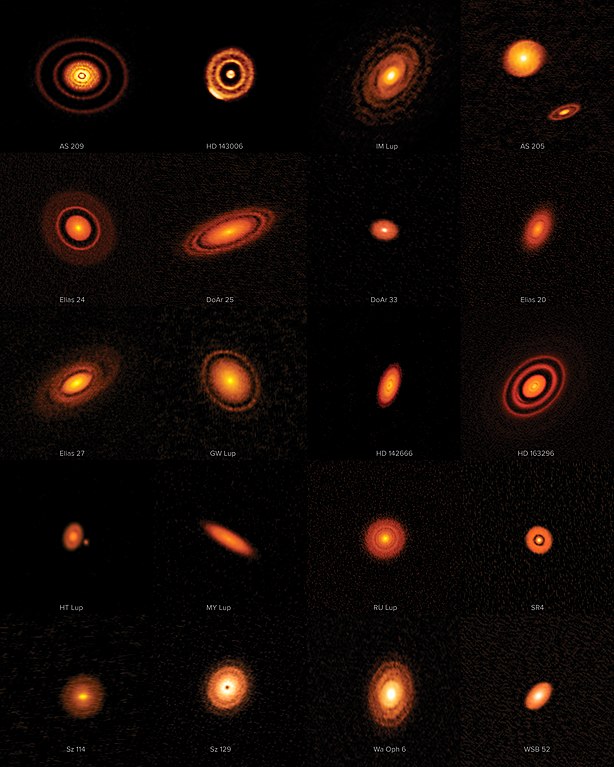
Caption: Click on the image and then click on the next one to see the protoplanetary disks in close-up.
Features:
- Original Caption:
- "The image shows
20
spectacular protoplanetary disks
captured by
ALMA's (Atacama Large Millimeter Array
first Large Program, known as the
Disk Substructures at High Angular Resolution Project (DSHARP).
In a focused observation effort that included hours of
data
collected over several months,
researchers imaged 20
nearby protoplanetary disks
to learn more about the earliest stages of
planet formation,
and the staggering quantity of data
from DSHARP
has just been released.
- It has long been thought that
planetary systems
are likely to have their origins in so-called
protoplanetary disks---compressed
circles,
ellipses, or
spirals
of gas and dust,
which form around protostars
in the early stages of their development. The process by which
planets emerge from the diffuse
protoplanetary disks,
however, is NOT well understood. It is particularly challenging to understand
the very earliest stages of their evolution when dust within a
protoplanetary disk coalesces
into planetesimals and
the seeds of planets are formed.
- Astronomers
(specifically planetologist)
know that a planet's first growth spurt,
from individual grains to a body a few kilometers
across, must happen quickly in astronomical terms, but the lack of observational
data has made pinning down the
physics of this growth challenging.
Fortunately, this recently changed with the opening of new
telescopes such as
ALMA.
- Eventually, astronomers hope to be
able to accurately predict what type of
planetary system will evolve
from any particular protoplanetary disk.
DSHARP takes us a step towards
this goal by providing a detailed view of the substructures (the varied patterns
of dark and light
circles,
ellipses, or
spirals you can see in each
protoplanetary disk), and so
help us to understand their significance."
- (Somewhat edited.)
- "The image shows
20
spectacular protoplanetary disks
captured by
ALMA's (Atacama Large Millimeter Array
first Large Program, known as the
Disk Substructures at High Angular Resolution Project (DSHARP).
In a focused observation effort that included hours of
data
collected over several months,
researchers imaged 20
nearby protoplanetary disks
to learn more about the earliest stages of
planet formation,
and the staggering quantity of data
from DSHARP
has just been released.
- Note
ALMA is
array of 66
radio telescopes operating
in the
submillimeter band (∼ 0.1--1 mm).
Thus, the images are all
false color.
- ALMA is located in
the Atacama Desert
in northern Chile
and is operated by
ESO.
Image link: Wikimedia Commons: File:Pitch perfect in DSHARP at ALMA.jpg.
Local file: local link: protoplanetary_disks_alma.html.
File: Planetary systems file: protoplanetary_disks_alma.html.